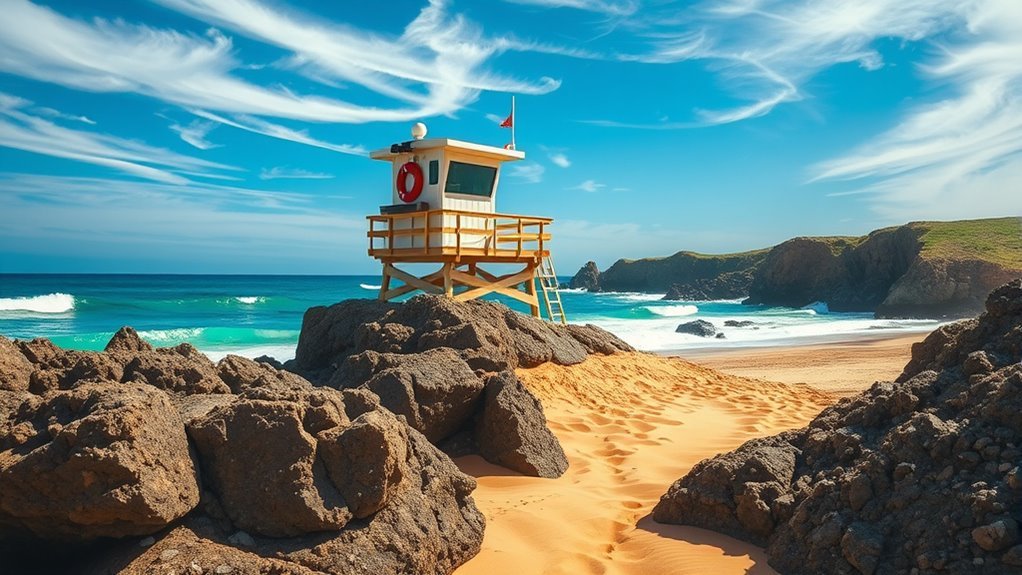When you’re planning to visit unique beaches, safety should be your top priority. Stick to swimming in areas monitored by lifeguards who can spot hazards and respond quickly if needed. Be mindful of rip currents, and know how to escape them. It’s important to protect yourself from the sun and stay hydrated. Additionally, respecting the environment is crucial to preserving its beauty. Ready to explore more tips for a safe beach experience? Learn more about Safety Tips for Visiting Unique Beaches.
Key Takeaways
- Always swim in designated areas that lifeguards monitor to ensure your safety.
- Remain vigilant about rip currents; if caught in one, swim parallel to the shore.
- Protect yourself from the sun with sunscreen, hats, and proper hydration.
- Respect the environment by cleaning up trash and using designated paths.
- Familiarize yourself with local emergency protocols and always carry a first aid kit.
Swimming in Supervised Areas

When you head to the Beach, make certain you swim in designated areas monitored by lifeguards. These professionals are trained to spot hazards and respond swiftly in emergencies.
Swimming in the ocean comes with risks, such as unpredictable currents and rips, so it’s essential to prioritize safety. Lifeguards provide critical information about safe swimming spots, helping you avoid dangerous water conditions.
Even if you’re confident in your swimming abilities, don’t underestimate the power of the ocean. Rip currents can catch anyone off guard; consequently, always follow lifeguard instructions and stay within the marked zones.
For children and inexperienced swimmers, having a lifeguard nearby ensures that immediate help is available, thereby reducing the risk of accidents.
Stay safe and enjoy your beach day!
Rip Current Awareness
Although enjoying a day at the beach is a favorite pastime, it’s vital to be aware of rip currents, which are a significant cause of drowning incidents.
Rip currents can form in any large open water area, including beaches and the Great Lakes. They are strong currents that can overpower even the strongest swimmers, so understanding beach safety tips is important.
- Stay calm and avoid panicking.
- Swim parallel to the shore to escape the current.
- Call for help if you’re unable to swim out.
Always consult a lifeguard about current conditions and potential rip current hazards.
Maintain a distance of at least 100 feet from piers and jetties where rip currents are more likely.
Sun Protection aWhenration

Beach is enjoying a day at the beach. It’s essential to prioritize sun protection and ensure an enjoyable experience.
Begin by applying a broad-spectrum sunscreen with an SPF of at least 30 to protect your skin from harmful UV rays. Remember to reapply every two hours or immediately after swimming.
To prevent dehydration, drink plenty of water—aim for at least 8 ounces every hour, especially in hot weather.
Use additional sun protection by wearing a wide-brimmed hat, UV-protective clothing, and sunglasses to protect yourself further. Seek shade whenever possible, particularly between 10 AM and 4 PM, when the sun’s rays are strongest.
Check the UV index before heading out; a higher index requires increased sun protection measures to keep your skin safe.
Environmental Responsibility
Environmental responsibility at the beach is essential for preserving its beauty and biodiversity. Start by keeping beaches clean; picking up trash protects local wildlife and enhances the beach experience.
Respect fragile ecosystems by staying on designated paths and preventing harm to habitats.
- Educate others about maintaining a clean environment to foster collective action against littering.
- Lifeguards support clean-up efforts, improve only, and strengthen the Beach Spirit.
- Leave the beach cleaner than you found it, ensuring sustainability for future visitors.
Emergency Response Preparedness

Before heading to a unique beach, confirm you’re prepared for emergencies to enhance safety for yourself and others.
First, familiarize yourself with local emergency numbers and locate emergency phones. This guarantees quick access to help if needed.
Always carry a first aid kit with essentials like bandages and antiseptic for minor injuries. If you see someone in distress, call for help or notify a lifeguard immediately. Don’t attempt unless you’re Beach’s trained.
Learn Beach’s emergency protocol, including how to report a missing person and how to handle encounters with marine animals.
Staying safe means staying informed, so remain calm and follow the instructions of emergency personnel during incidents.
Prioritizing these steps guarantees safety for yourself and those around you.
Conclusion
When visiting unique beaches, always swim in areas supervised by lifeguards and stay aware of rip currents by swimming parallel to the shore if necessary. Don’t forget to protect yourself from the sun with sunscreen, protective clothing, and plenty of water. The beach ciishchronicle bis cleanhandefollows localcols. By doing these things, you’ll ensure a safe, enjoyable, and environmentally friendly beach experience.
FAQs
1. What Are Some Safety Measures One Should Take While at the Beach?
You should always swim in designated lifeguard areas, stay aware of tides, follow flag warnings, and stay hydrated. Apply SPF 30 sunscreen frequently, and never swim alone to ensure your safety at the beach.
2. How to Be Safe on a Beach?
Beach safety is crucial, including swimming in lifeguard-protected areas, entering the water feet-first, and watching for warning flags. Stay aware of rip currents and keep children close to you. Always follow posted guidelines to prevent accidents.
3. What Are the 10 Water Safety Tips?
You should always swim in lifeguarded areas, never go alone, and be mindful of tides and rip currents. Enter feet first, dive only in marked safe places, and be familiar with local emergency contacts. Stay alert and prepared. Should we be careful?
4. What Should I Be Careful of at the Beach?
At the beach, watch for rip currents and unexpected tides. Enter the water feet first to avoid injury. Keep an eye on weather changes and be aware of your surroundings, including rocks and marine life, for a safe experience.

